The Rising Costs of Extreme Weather Events
On September 20, 2017, it took Hurricane Maria just hours to erase decades of economic progress in Puerto Rico. Winds of over 150 mph destroyed most of the island’s electricity, cellular, and transportation networks, with the most vulnerable Puerto Ricans suffering disproportionately. More recently, record-breaking heavy rains and floods devastated areas in Missouri and Eastern Kentucky.
Economic harms from extreme weather and climate events have become more commonplace due to increasing temperatures, sea levels, and economic development in areas vulnerable to these events. In recent years, the United States has experienced, on average, more than one disaster that has caused over a billion dollars in damages each month. To put this in perspective, until this past decade, the country rarely experienced a year with more than a handful of billion-dollar weather and climate disasters (see Figure 1).
Policymakers need clear-eyed assessments of these economic harms. Yet, predicting either the immediate costs or the longer-term implications of extreme weather events is difficult. Part of the issue is that models typically rely on historical data, which in this case means looking to data informed by a climate that no longer prevails now that carbon dioxide levels are higher than they have been in millennia and continue to increase.
Economists are also amidst a paradigm change in the methods they deploy to assess the immediate and longer-term economic harms from extreme weather events. There is an urgent need to build on newer methods that can provide insight into how to assess economic harms in a chaotic climate. This blog lays out how shifts in economic methods are altering the measurement of the costs of extreme weather events and climate change more broadly.
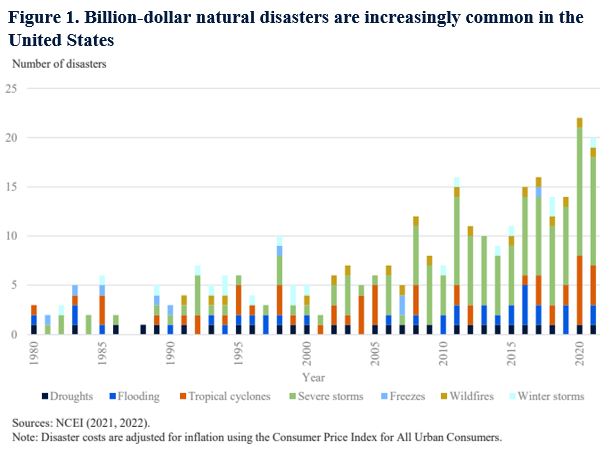
Measuring direct and indirect costs of extreme weather in the United States
The best source for the direct costs of extreme weather is the National Oceanic and Atmospheric Administration (NOAA). Core to its mission, NOAA tracks and analyzes the severe weather and climate events that have hit the United States since 1980, assessing categories of disasters that include tropical cyclones, floods, droughts, heat waves, tornados, hail storms, wildfires, crop freeze events, and winter storms. Their data show that the year 2021 was reported as the third most costly on record, with 20 weather and climate disasters (see Figure 2) causing roughly $150 billion in damages in the United States, with about half of the costs coming from Louisiana’s Hurricane Ida alone. In addition, these disasters are killing Americans. According to data from NOAA, nearly one thousand people died in 2021 from extreme weather events.
There are also indirect costs, which can have long-lasting effects. For example, an analysis by the JPMorgan Chase Institute shows that in the week prior to Hurricanes Harvey and Irma, spending on items like fuel, groceries, and home expenses rose 15 to 37 percent while spending on health care fell, which illustrates the costly sacrifices families are making to prepare for extreme weather. Then, during the week these storms made landfall, economic activity in the regions slowed, and checking account inflows dropped by over 20 percent, or roughly $400 per customer, which were backbreaking losses for families trying to make ends meet.
The negative effects on household finances can persist for years after the extreme weather event, particularly among the financially vulnerable. One study finds average credit scores fall by about 10 to 20 points among those affected by “medium-sized disasters” (defined as disasters that cause under $200 million in damages but are large enough to receive FEMA Individuals and Households Program assistance), meaning that many Americans fall below the traditional thresholds for “fair” (650) or “good” (700) credit levels.
Indirect costs accrue even to those who are not directly affected by the event itself. For example, the majority of American homeowners are paying more for homeowners insurance than they used to, with recent annual increases over $100 for households where premiums are rising. Americans pay for extreme weather as taxpayers as well—a Congressional Budget Office analysis found that the Federal government spending on hurricane disaster relief is growing, with Federal spending equal to approximately 60 percent of the value of hurricane damages.
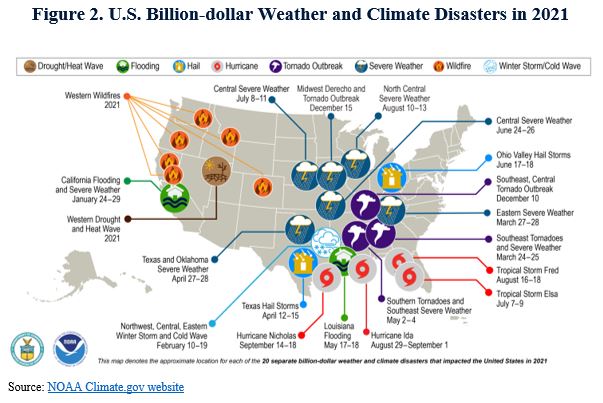
A single disaster has long-lasting effects on economic growth
The damage caused by these weather events does not end once the storm debris is cleared; reductions in economic growth can be seen years later. Figure 3 lays out three basic pathways illustrating the potential longer-term effects on economic growth. The first two pathways are either 1) the region returns to its preexisting economic growth trend (“recovery to trend”); or 2) the region actually moves onto a faster growth path because the disaster itself provides the impetus to update capital stock and adopt new technologies (“creative destruction”). Economists have often assumed that one of these two scenarios prevails, given that a weather disaster is typically a one-off event and that society has the time and resources to recover and rebuild.
However, the bulk of the empirical evidence suggests extreme weather has long-lasting negative effects on economic growth, i.e. the “no recovery” pathway in Figure 3. For example, a series of papers by Sol Hsiang and Amir Jina assesses the long-term economic effects of cyclones (called hurricanes or tropical storms when they occur in the Atlantic Ocean). Using data on every severe storm on the planet over decades, they estimate how GDP evolves as a function of the maximum wind speed of the storm. Their main result is displayed in Figure 4: after 15 years, GDP is 0.38 percentage points lower for every additional 1 meter per second of wind speed exposure. Whether due to insufficient government responses or simply overwhelming damages, economies have failed to swiftly recover from disasters.
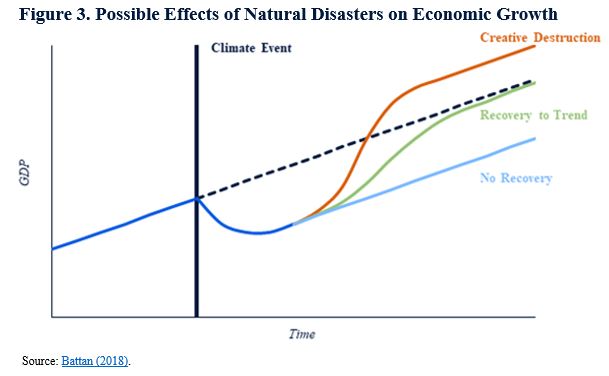
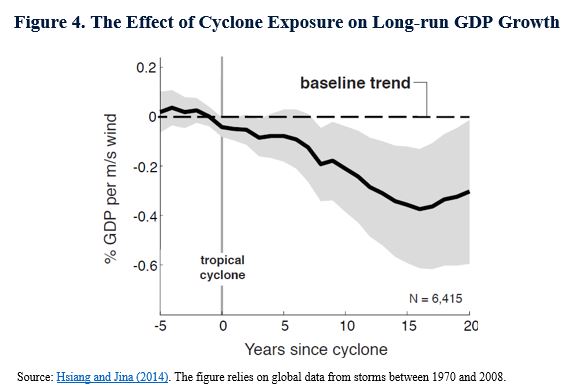
Economies often fail to fully recover from disasters because climate change is increasing the frequency, intensity, and duration of certain extreme events. The warming of the planet is increasing the prevalence of severe heat waves, worsening droughts due to additional evaporation, and exacerbating storms by creating more moisture in the atmosphere. Places that are particularly vulnerable include those more likely to experience extreme weather and those where the current infrastructure was built for climate conditions that no longer prevail.
However, while economists have developed a better understanding of the consequences of each disaster, the extent of the drag on future economic growth due to the increased regularity and severity of disasters—or more systemic environmental failures—is largely unknown. Quantitative projections are hampered by the massive uncertainties about the degree to which a warming planet will affect complex phenomena like hurricanes and wildfires, including the damages they will cause and how well we will adapt. Adding to the challenge, climate change is a threat-multiplier that can cause cascading damages to interconnected systems, including energy, health, water, food, and ecosystems.
A flurry of recent econometric studies and working papers ask a related but different question: on a warming planet, what are the implications of the historical correlations between temperature changes and economic growth rates? Such studies may capture some of the more gradual damages caused by hotter temperature, for example, to labor supply and productivity, human capital development, and crop yields. One prominent analysis suggests that countries’ growth rates of output per capita peak at an average annual temperature of around 55° F (13° C)—which is near the current average annual temperature in the United States—and decline strongly at higher temperatures (see Figure 5). Their findings suggest that the economic damages caused by climate change accumulate over time, with estimates roughly ten times larger than suggested by the previous generation of models that did not consider the persistent effects of climate change on economic growth.
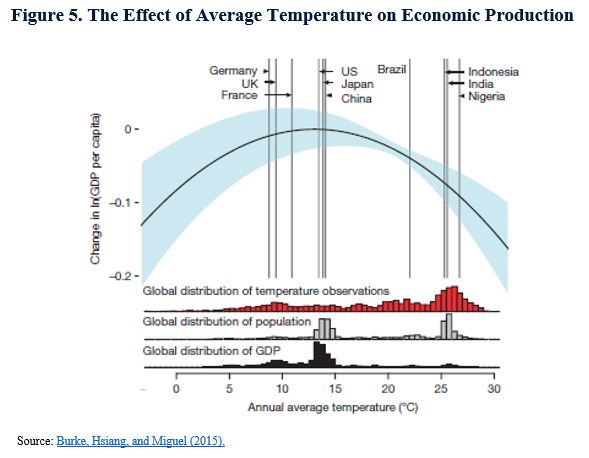
Conclusion
The costs of extreme weather are growing. Economies struggle to recover from single disasters, let alone the more frequent and severe disasters caused by climate change.
Economists are working to develop methods that can provide useful assessments of the economic harms from extreme weather and climate events. More realistic fiscal planning is a goal of current work at the Council of Economic Advisers (in collaboration with other Federal agencies) to embed the effects of climate change into macroeconomic analysis and through a new National Academies’ Roundtable on Macroeconomics and Climate-related Risks and Opportunities. A better understanding of the costs of extreme weather and climate events can help to improve resilience to these events and enable budgeting that provides sufficient support for at-risk communities—for example, FEMA’s Loss Avoidance Studies estimate the damages prevented by projects that build resilience to disasters, often demonstrating the cost-effectiveness of these investments. In addition, better risk assessments provide a strong rationale to rapidly shift to cleaner methods of economic production in order to avoid the daunting threats posed by a high-emissions future.

